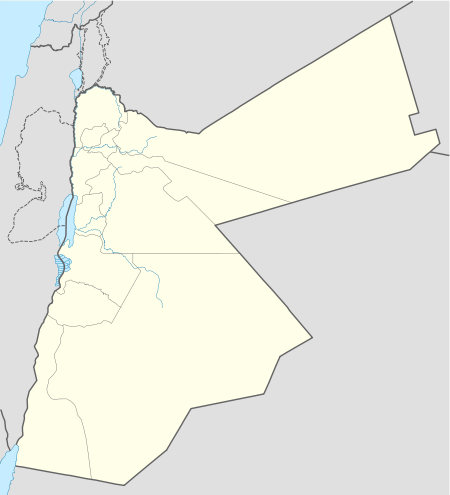Ghassulian


| Chalcolithic Eneolithic, Aeneolithic or Copper Age |
|---|
| ↑ Stone Age ↑ Neolithic |
|
| ↓ Bronze Age |
Ghassulian refers to a culture and an archaeological stage dating to the Middle Chalcolithic Period in the Southern Levant (c. 3800–c. 3350 BC).[1] Its type-site, Teleilat Ghassul (Teleilat el-Ghassul, Tulaylat al-Ghassul), is located in the Jordan Valley near the Dead Sea in modern Jordan and was excavated in the 1930s.
The Ghassulian stage was characterized by small hamlet settlements of mixed farming peoples, and migrated southwards from today's Syria into today's Jordan, Israel and Palestine. Houses were trapezoid-shaped and built mud-brick, covered with remarkable polychrome wall paintings. Their pottery was highly elaborate, including footed bowls and horn-shaped drinking goblets, indicating the cultivation of wine. Several samples display the use of sculptural decoration or of a reserved slip (a clay and water coating partially wiped away while still wet). The Ghassulians were a Chalcolithic culture as they also smelted copper. Funerary customs show evidence that they buried their dead in stone dolmens.[2]
Ghassulian culture has been identified at numerous other places in what is today southern Israel, especially in the region of Beersheba. The Ghassulian culture correlates closely with the Amratian of Egypt and may have had trading affinities (e.g., the distinctive churns, or “bird vases”) with early Minoan culture in Crete.
Definition
Ghassulian, a name applied to a Chalcolithic culture of the southern Levant, is derived from the eponymic site of Teleilat (el) Ghassul, northeast of the Dead Sea in the Great Rift Valley. The name has been used as a synonym for Chalcolithic in general and sometimes for late phases, associated with late strata at that site and other sites considered to be contemporary. More recently it has come to be associated with a regional cultural phenomenon (defined by sets of artifacts) in what is today central and southern Israel, the Palestinian territories in the West Bank, and the central area of western Jordan; all either well-watered or semi-arid zones. Other phases of the Chalcolithic, associated with different regions of the Levant, are Qatifian and Timnian (arid zones) and Golanian. The use of the name varies from scholar to scholar.
Dates and transition phases
The Ghassulian, if used as a synonym for the entire Chalcolithic period and not, as more appropriately, just to the Late Chalcolithic, followed a Late Neolithic period and was succeeded by an Early Bronze I (EB I) period. Little is understood of the transition from the latest Chalcolithic to the earliest EB I, but there was apparently some transition of ceramic, flint-knapping and metallurgical traditions, especially in the southern regions of the southern Levant. The dates for Ghassulian are dependent upon 14C (radiocarbon) determinations, which suggest that the typical later Ghassulian began sometime around the mid-5th millennium and ended ca. 3800 BC. The transition from Late Ghassulian to EB I seems to have been ca. 3800-3500 BC.
See also
- Chalcolithic Temple of Ein Gedi
- Nahal Mishmar, where artifacts possibly originating at the Chalcolithic Temple of Ein Gedi were found
- Pre-history of the Southern Levant
- History of pottery in the Southern Levant
- Syro-Palestinian archaeology
- Proto-Semitic homeland
References
- ↑ Hitti, 2004, p. 26.
- ↑ A. Gorzalczany, "Centre and Periphery in Ancient Israel: New Approximations to Chalcolithic Funerary Practices in the Coastal Plain", Antiguo Oriente 5 (2007): 205-230.
Bibliography
- Bourke, S. J. (1997): The “Pre-Ghassulian” Sequence at Teleilat Ghassul: Sydney University Excavations 1975-1995. pp. 395–417 in H. G. K. Gebel, Z. Kafafi and G. O. Rollefson, eds. The Prehistory of Jordan, II: Perspectives from 1997 (Studies in Early Near Eastern Production, Subsistence, and Environment 4). Berlin: Ex Oriente.
- Bourke, S. Zoppi, U., Meadows, J., Hua, Q., and Gibbins, S. (2004): The end of the Chalcolithic Period in the south Jordan Valley: New 14C Determinations from Teleilat Ghassul, Jordan. Radiocarbon 46/1: 315-323.
- Epstein, C. (1998): The Chalcolithic Culture of the Golan. Jerusalem: The Israel Antiquities Authority (IAA Reports 4).
- Gilead, I. (1988): The Chalcolithic Period in the Levant. Journal of World Prehistory 2:397-443.
- 1994 The History of the Chalcolithic Settlement in the Nahal Beer Sheva Area: The Radiocarbon Aspect. Bulletin of the American Schools of Oriental Research 296: 1-14.
- 2011 Chapter 2: Chalcolithic Culture History: Ghassulian and Other Entities in the Southern Levant. pp. 12–24 in (eds.) J. L. Lovell and Y. M. Rowan. Culture, Chronology and the Chalcolithic: Theory and Transition (CBRL Levant Supplementary monograph series Vol. 9). Oxford and Oakville: Oxbow Books.
- Joffe, A. H. and Dessel, J. P. (1995): Redefining Chronology and Terminology for the Chalcolithic of the Southern Levant. Current Anthropology 36: 507-518.
- Klimscha, F. (2009): Radiocarbon Dates from Prehistoric cAqaba and Other Related sites from the Chalcolithic Period. pp. 363–419 in eds. Khalil, Prehistoric ‘Aqaba I (Orient-Archäologie Band 23). Verlag Marie Leidorf GmbH: Rahden, Westfalia, German Democratic Republic.
- Levy, T. E. (1986): The Chalcolithic Period. Biblical Archaeologist 49: 82-108.
- Lovell, J. L. (2001): The Late Neolithic and Chalcolithic Periods in the Southern Levant. New Data from the Site of Teleilat Ghassul, Jordan (Monographs of the Sydney University Teleilat Ghassul Project 1; BAR International Series 974). Oxford: British Archaeological Reports.
- Hitti, Philip Khuri (2004), History of Syria including Lebanon and Palestine, Gorgias Press LLC, ISBN 978-1-59333-119-1, ISBN 1-59333-119-3
External links
- Paul James Cowie, Archaeowiki: Teleilat Ghassul
- Andie Byrnes, The Chalcolithic
- Paul James Cowie, Archaeowiki: Chalcolithic of the Southern Levant
Coordinates: 31°51′39″N 35°38′26″E / 31.86083°N 35.64056°E